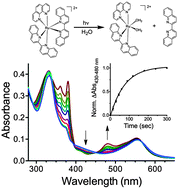Light-activated ruthenium complexes photobind DNA and are cytotoxic in the photodynamic therapy window†
Abstract
Incorporation of biquinoline ligands into Ru(II) polypyridyl complexes produces light-activated systems that eject a ligand and photobind DNA after irradiation with visible and near-IR light. Structural analysis shows that distortion facilitates the photochemistry, and gel shift and cytotoxicity studies prove the compounds act as anti-cancer photodynamic therapy (PDT) agents in the tissue penetrant region.


 Please wait while we load your content...
Please wait while we load your content...